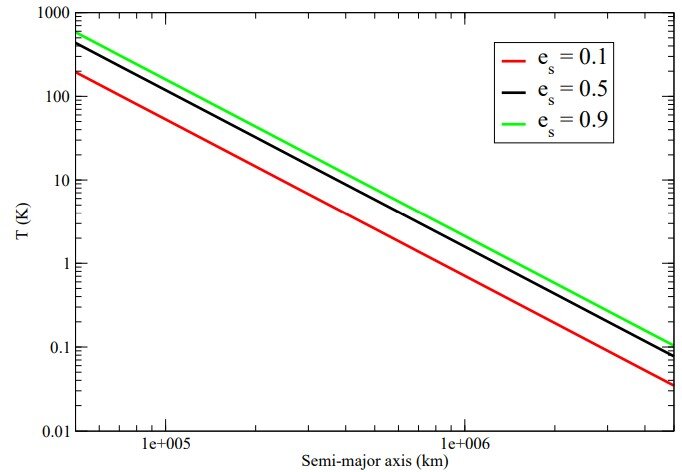
2.22.23

The colored lines indicate the predicted temperature T of the satellite for different values of orbital eccentricity (es = 0.1, es = 0.5 and es = 0.9). Here, we have neglected the solar heating effect and we have assumed R = 100 km.
There is a mystery in our solar system surrounding the orbits of Kuiper belt objects.

More than one trillion icy objects smaller than our moon orbit the sun in a donut-shaped ring beyond Neptune. Oddly, a cluster of outer Kuiper belt objects all ellipse in a similar way, as though being gravitationally pulled in one direction. The leading hypothesis is that an unseen object, five to 10 times the mass of Earth, is causing the pulling effect. The mystery object has been dubbed Planet 9.
Observations have yet to discover the source of this gravity from the usual optical, microwave, infrared or electromagnetic wave spectrums, leading to speculation that it could be a rogue planet core, a small black hole, or even a cluster of dark matter. Any of these would make the object extremely difficult, if not impossible, to detect.
An unconventional detection approach has been proposed by Man Ho Chan, associate professor in the Department of Science and Environmental Studies at The Education University of Hong Kong. In his paper which has been accepted for publication in The Astrophysical Journal [below], Chan focuses on the potential existence of satellites orbiting Planet 9.
While looking for moons around a planet that hasn’t been found might initially sound like a more difficult task than finding the planet itself, Chan illustrates that if Planet 9 has satellite objects, those objects would have fluctuating heat signatures as they orbit due to the process of tidal heating. These heat signatures would be 2.5 times higher than the expected range for Planet 9 itself, and would also be much higher than any known Kuiper belt objects. Signatures in this range should be detectable by the Atacama Large Millimeter/submillimeter Array Observatory (ALMA), which has recently undergone a capability upgrade.

It is known that objects within the Kuiper belt can have satellites. Pluto, the dwarf planet smaller than our moon and former ninth planet in our solar system, is within the Kuiper belt and has five moons.
Is there really a Planet 9?
Astronomers Mike Brown and Konstantin Batygin of the California Institute of Technology, after initially attempting to prove that no such planet was required, have given the strange outer orbits a .02% to .04% chance of naturally occurring without a Planet 9 type body affecting their orbit. Despite initial skepticism, in 2016, they published a paper in The Astrophysical Journal [below] and have since narrowed down the mass and potential orbital locations of Planet 9.
According to Chan, the CalTech astronomers’ proposed mass for Planet 9 could accommodate as many as 20 satellites, increasing its chances of observable tidal force heat signatures.
Why haven’t we already found it?
If it is a rogue planet or a remnant planetary core, having survived an early solar system game of planetary billiard balls, it could have an eccentric orbit. As good as we are at spotting things far away, those objects tend to be trackable over time because orbits are mostly on the same plane and moving in the same direction around the sun. An orbit not on that plane and going in a different direction, regardless of size, would be exceedingly hard to track.
If a black hole is causing the pull, one measured in Earth masses and not the usual solar masses, it would be small enough to fit nicely into an elementary school backpack. This small size makes gravitational lensing and gamma-ray emissions too faint to register and would require an expansion of the standard model to accommodate its existence.
And dark matter is so named precisely because it has avoided all methods of detection except gravitational influence on much larger scales.
Yet any of these possible objects could support satellites. Thanks to Chan’s work, we now have a good strategy for finding them. Since there are no other astrophysical mechanisms past Neptune that could increase temperatures to the ranges detailed in his paper, the satellites should stand out against the colder background and offer a clear signal that Planet 9, no matter how dark, is out there.
The Astrophysical Journal
The Astrophysical Journal 2016
See the full article here .
Comments are invited and will be appreciated, especially if the reader finds any errors which I can correct. Use “Reply”.
five-ways-keep-your-child-safe-school-shootings
Please help promote STEM in your local schools.
About Science X in 100 words
Science X™ is a leading web-based science, research and technology news service which covers a full range of topics. These include physics, earth science, medicine, nanotechnology, electronics, space, biology, chemistry, computer sciences, engineering, mathematics and other sciences and technologies. Launched in 2004 (Physorg.com), Science X’s readership has grown steadily to include 5 million scientists, researchers, and engineers every month. Science X publishes approximately 200 quality articles every day, offering some of the most comprehensive coverage of sci-tech developments world-wide. Science X community members enjoy access to many personalized features such as social networking, a personal home page set-up, article comments and ranking, the ability to save favorite articles, a daily newsletter, and other options.
Mission: 12 reasons for reading daily news on Science X Organization Key editors and writers include 1.75 million scientists, researchers, and engineers every month. Phys.org publishes approximately 100 quality articles every day, offering some of the most comprehensive coverage of sci-tech developments world-wide. Quancast 2009 includes Phys.org in its list of the Global Top 2,000 Websites. Phys.org community members enjoy access to many personalized features such as social networking, a personal home page set-up, RSS/XML feeds, article comments and ranking, the ability to save favorite articles, a daily newsletter, and other options.
